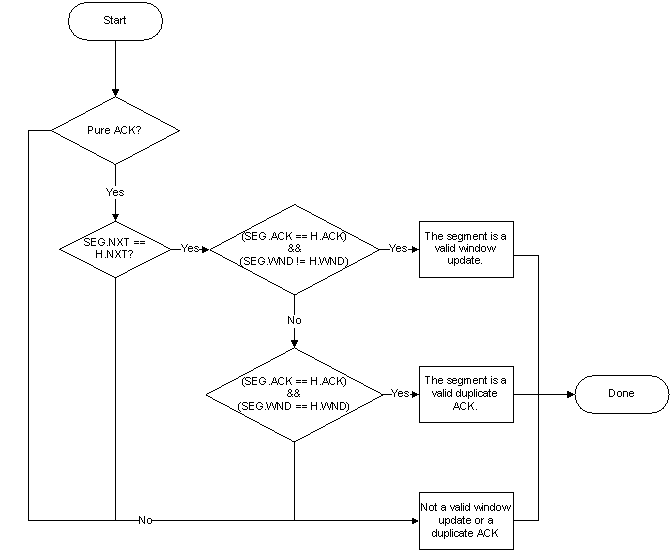Examples of Receive Segment Coalescing
This section illustrates the coalescing algorithm by using examples of segments that are received in order and processed in a single deferred procedure call (DPC).
This page uses X and X’ for labeling successive segments. All other segment and single coalesced unit (SCU) fields are as described in Rules for Coalescing TCP/IP Segments.
Example 1: Data segments
Segment Description
10 successive segments belonging to the same TCP connection are processed. All of the following conditions are true for each:
X’.SEQ == X.NXT
X’SEQ > X.SEQ
X’.ACK == X.ACK
None of these segments generates an exception.
Result
A single SCU is formed out of the 10 segments. This is indicated as a single NET_BUFFER in a single NET_BUFFER_LIST.
Example 2: Data segments, followed by an exception, followed by data segments
Segment Description
5 successive segments belonging to the same TCP connection are processed. All of the following conditions are true for each:
X’.SEQ == X.NXT
X’SEQ > X.SEQ
X’.ACK == X.ACK
None of these segments generates an exception. The 6th segment is a duplicate ACK segment with a TCP SACK option and generates an exception based on rule number 3 in Rules for Coalescing TCP/IP Segments.
Note In this case, the exception rule for handling a TCP option takes precedence and thus overrides the coalescing rule.
2 successive segments belonging to the same TCP connection are processed. All of the following conditions are true for each:
X’.SEQ == X.NXT
X’SEQ > X.SEQ
X’.ACK == X.ACK
None of these segments generates an exception.
Result
A single SCU is formed out of the first 5 segments. The 6th segment does not form an SCU.
The 7th and 8th segments form an SCU together.
A NET_BUFFER_LIST chain is indicated with three NET_BUFFER_LIST structures each having a single NET_BUFFER. The ordering of received segments is maintained.
Example 3: Data segments, followed by multiple window updates
Segment Description
5 successive segments belonging to the same TCP connection are processed. All of the following conditions are true for each:
X’.SEQ == X.NXT
X’SEQ > X.SEQ
X’.ACK == X.ACK
None of these segments generates an exception. The 6th segment is a pure ACK that is a window update with SEG.WND = 65535 as shown in the following flowchart.

The 7th segment is a pure ACK that is a window update with SEG.WND = 131070 as shown in the same flowchart.
Result
A single SCU is formed out of the 7 segments. This is indicated as a single NET_BUFFER in a single NET_BUFFER_LIST.
The SCU.WND = 131070, and the checksum is updated based on this value.
Example 4: Piggybacked ACKs mixed with data segments
Segment Description
3 successive segments belonging to the same TCP connection are processed. All of the following conditions are true for each:
X’.SEQ == X.NXT
X’SEQ > X.SEQ
X’.ACK == X.ACK
None of these segments generates an exception. 2 successive segments belonging to the same TCP connection are processed. All of the following conditions are true for each:
X’.SEQ == X.NXT
X’SEQ > X.SEQ
X’.ACK == X.ACK
None of these segments generates an exception.
Result
A single SCU is formed out of the 5 segments. This is indicated as a single NET_BUFFER in a single NET_BUFFER_LIST. The SCU.ACK is set to the last SEG.ACK.